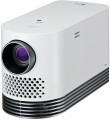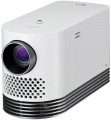Operating system
—
Smart TV (proprietary system). The operating system of the projector is represented by the proprietary software shell of the manufacturer. Usually such operating systems have an attractive and convenient menu, similar to a traditional Smart TV. A proprietary operating system is developed by the manufacturer for the hardware resources of a particular projector model or a whole line. But, as practice shows, compared to the classic Smart TV, the functionality of proprietary system often has significant limitations, and the system itself, in fact, is a stripped-down version of a full-fledged Smart TV.
—
Smart TV (Android AOSP). This type of operating system is a modification of the popular Android OS, mainly notable for being open source. It is a versatile operating system that gives the user much more freedom to create changes and customizations within the system. At the same time, the installation and work stability of certain applications on this platform are not guaranteed, and the overall system management was not specially “tailored” for large screens, which may cause some inconvenience. First of all, such solutions will will generate interest among users who understand the features of the Android OS, like to customize and control everything, and have time for this.
—
Android TV. This type of projector has full-fledged Android TV software, spec
...ially adapted to work on large screens. In accordance with the name, it is a type of Android OS, specially designed for projectors/TVs, etc. In addition to the common features of all “Androids” (such as the ability to install additional applications, including even games), it has a number of special features: optimized interface, integration with smartphones (including the ability to use them as a remote control), voice search, etc. Thanks to this, TVs with this feature are significantly superior in functionality to models with a Smart TV. Of course, a dedicated processor, graphics subsystem and memory are provided for the operation of a multifunctional OS, and the presence of such hardware resources is reflected in the total cost of the projector. Given the same optical design, models with Android TV will cost more than classic projectors with a simple multi-line menu.Bluetooth
Bluetooth version supported by the projector.
By itself, Bluetooth technology is designed for direct wireless connection between different devices. In projectors, this connection is most often used to broadcast sound to wireless headphones or speakers; Other uses of Bluetooth are possible (for example, connecting a remote control), but they are rare. Thus, you can not pay much attention to the specific version of Bluetooth supported by the projector — all versions are compatible with each other at least in basic functionality (including sound transmission).
Wi-Fi
Wi-Fi standard supported by the projector.
Wi-Fi is known mainly as a way to connect wirelessly to the Internet and local networks. In addition, since relatively recently, this technology has also been used for direct connection between wireless devices. Accordingly, the methods of using Wi-Fi in projectors can also be different. Thus, some models are able to connect to local networks to work with content via DLNA (see above); in others, such a connection is used for control from a computer or other network device; in others, a “remote control” such as a smartphone or tablet can connect directly via Wi-Fi.
As for Wi-Fi versions, the most popular options in modern technology -
Wi-Fi 6 (802.11ax),
Wi-Fi 5 (802.11ac) - are quite compatible with each other, and the difference between them in this case is not critical. Therefore, you can not pay special attention to these details when choosing.
There are also
Wi-Fi ready projectors, which do not have Wi-Fi out of the box, but when connected to the appropriate adapter (purchased separately) are capable of wireless connection.
AirPlay
The projector supports AirPlay technology. We are talking here about both the original technology (when the presence of AirPlay is simply indicated, without clarification), and about version v.2 - compatibility with this version is directly indicated in the characteristics.
In general, AirPlay is a proprietary Apple technology designed primarily for broadcasting video and audio signals from iPhone, iPad and other Apple gadgets to external playback devices. So it makes sense to specifically look for such a projector mainly if you plan to broadcast content from Apple gadgets to it. However, third-party equipment can also act as a signal source - for example, a laptop with iTunes installed (or another compatible player). In any case, the broadcast is carried out via Wi-Fi, and the devices must be within the same network. The AirPlay bandwidth is enough to work with video in HD resolutions, and the transmitting gadget during such a broadcast also plays the role of a remote control for the receiving device.
In turn, AirPlay v.2 was a development and improvement of the original AirPlay. In the case of projectors, the main innovation is the ability to control playback through the Siri voice assistant.
Miracast
Miracast technology is designed to transmit streaming video over an IEEE 802.11n wireless channel. This technology is well suited for broadcasting "heavy" high-quality content. Thanks to Miracast, you can display video from a smartphone or a picture of a tablet / laptop screen on the projector in a matter of seconds. Miracast can be considered an optional Wi-Fi Direct application.
USB 2.0
The number of USB 2.0 ports provided by the projector.
Do not confuse these connectors with USB slave (see "Management ports") — in this case we are talking about
USB ports for various peripherals. Most often, these ports are used for direct playback of content from flash drives and other storages (for example, external HDDs). At the same time, we note that video viewing is not available in some projectors (only photos), in others a very limited set of formats may be supported. However, a direct connection is often more convenient than viewing through a computer or other device. The USB ports can also be used for other purposes, such as updating firmware, transferring files between a flash drive and the projector's built-in storage, or even for keyboards/mouses (in Android devices, see above).
The USB 2.0 standard itself is considered obsolete, but it is quite enough for projectors, and newer peripherals are fully compatible with such connectors. At the same time, you rarely have to connect more than one external device to the projector at a time, so there are few models with more than one USB 2.0.

